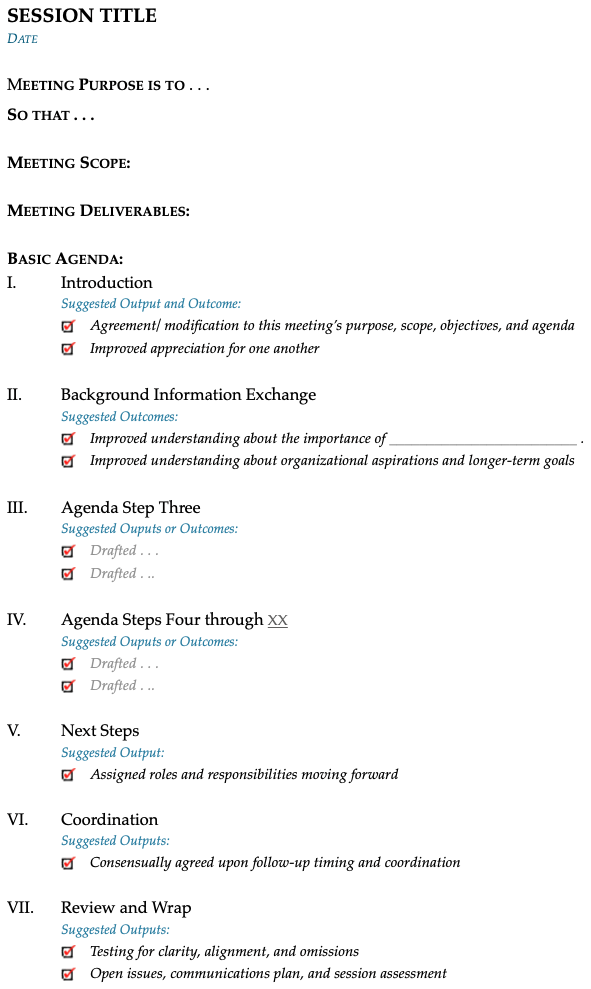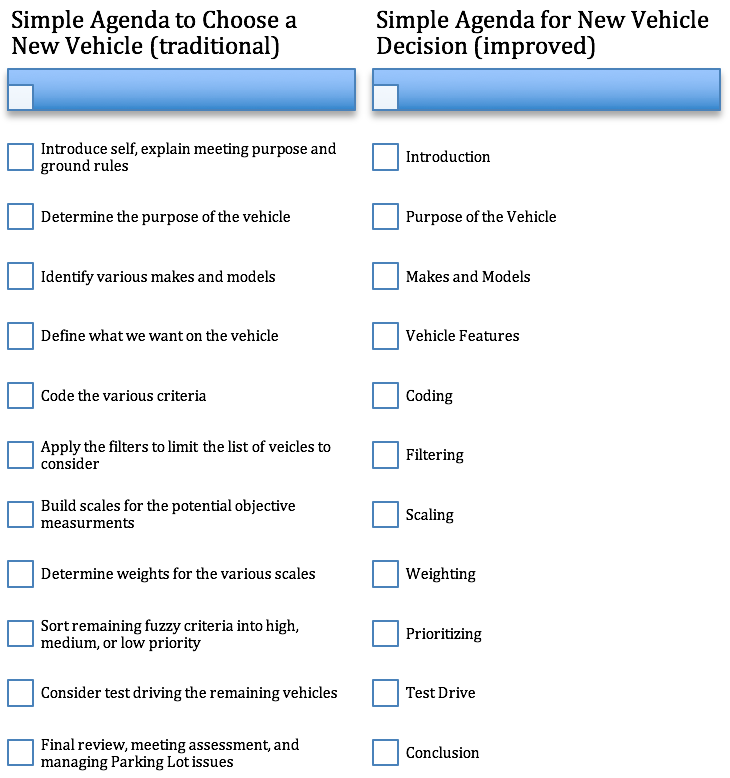Regardless of their personal style, experts and professionals who lead effective meetings rely on a simple, one-page meeting agenda.
(Templates for which we’ve included .docx and .rtf links for you to download below.)

This meeting agenda template focuses on what DONE looks like for all meeting agenda steps. It’s all about getting DONE because nobody wants more meetings or, especially, more time in meetings.
If completing this meeting agenda template only gets you to think clearer about your meeting purpose, scope, and deliverables, your preparation will have been rewarded. Once you revise the style of your meeting agenda template, you can modify or repurpose your future meeting agendas in a few minutes. Always stay focused on ‘“right to left” thinking, which means keeping the end in mind by knowing what DONE looks like.
Add Content to Your Meeting Agenda Template
Develop your meeting agenda template by adding your own content. Modify the picture below of the meeting agenda template or download a DOCX or RTF document.
Start with a clear statement of your meeting purpose. Then articulate your meeting scope, both what is included and what is excluded (IS NOT). Carefully spell out your meeting objectives, frequently called “deliverables.” For standard business practices, Steven Covey refers to the objectives as “the end in mind.” In Agile communities, you are expressing what DONE looks like. The Lean and Six Sigma communities may refer to it as using “right-to-left thinking,” where you go to the end of the written line and work backward (in the English language), from “right” (ending) to “left” (beginning).
While the first and last two agenda steps (Introduction and Wrap) repeat themselves from meeting to meeting, modify steps two through XX with content, questions, and activities that complete your meeting objectives. Two secrets for building a compelling, one-page agenda template include:
- The best meetings generate some type of action or follow-up, so make sure that all activities are assigned to someone in the meeting, and
- ‘If it wasn’t documented, it didn’t happen,” so be sure to distribute thorough meeting notes soon after the meeting concludes.
NOTE: We are very careful of rhetoric here. We do NOT ask “Who is going to do this?” Rather, we ask, “Who will take responsibility for reporting back to this group on the status of this?” As we all know, many volunteers re-assign the tasks to somebody that works for them.
Make it a 50-minute Meeting, Not 60
Learn to keep your meetings to fifty minutes by starting five minutes after and ending five minutes before the hour or half-hour. Stop treating your one-hour meetings too lightly with little or no preparation. Statistically, we waste more time and money in briefer meetings than full-day or multiple-day workshops.
All in, you cost your organization at least USD$150 per hour. With eight of you in a one-hour meeting, your “burn rate” will be around $20 per minute. Therefore, some organizations encourage meeting participants to NOT attend if there is no agenda because meeting time represents a high probability of wasted time. For optimal productivity, here is the framework for a field-tested meeting agenda template, which you can quickly modify for your fifty-minute meetings.
Download .docx file Agenda Template
Download .rtf file Agenda Template
Meeting Experts Note:
- All agendas, even a one-page agenda, should include a beginning, middle, and end. Do not skip the beginning or end. See other MGRUSH Best Practices for how to manage robust introductions and wraps.
- Capture participants in advance to anticipate modifications or additions. Since we expect our participants to own the meeting output, they should provide some voice as to HOW the output is derived.
- Crafting a simple, one-page agenda around the deliverable makes it easier to create the agenda steps required. For example, a “Wedding Plan” might include decisions about food, music, and ceremony. A project plan might include objectives and key results, situation analysis, alignment, and assignments.
- Distribute your completed and written meeting agenda before the meeting. Earlier is better, preferably as part of a “read-ahead”.
- Keep in mind that simple agenda steps ought to reflect WHAT, the objective (i.e., noun) of the step. Do not detail HOW (i.e., verb) you are going to facilitate the activity. Save the details, method, and tools for your private, annotated agenda or notes (see supporting rationale and more thorough explanation in the next section).
- Observe in the picture above that each agenda step should stress a discrete outcome (i.e., a condition) or output (i.e., something that can be documented).
- Time box strategic discussions unless you are hosting a strategic planning session. Strategic issues bog down many tactical and operational meetings. Defer strategic issues to a separate meeting time and place. In other words, most meetings waste time discussing stuff not related to the deliverable of the meeting or the agenda; i.e., scope creep within a meeting. And scope creep begins in meetings.
Nobody Wants More Meetings or Longer Meetings
Yet many of us find ourselves in meetings a few dozen hours per week (or more). Why do we meet so frequently since seldom do meetings remove stuff from our “To-Do” list? On the contrary, most meetings normally lead to more work. How do we fix this? Start with your agenda steps.
Your meeting participants do not want any more work, and verbs are work. We perform verbs so that our actions yield results, frequently called objects (hence the term objective). Objects are also known as nouns: persons, places, things, or events about which we need more information to make more informed decisions. Label your agenda steps as nouns because verbs add no value for participants.
Agenda Steps Too Frequently Stress Work (i.e., Verbs), Not Results (Objects)
Verbs like “identify” and “define” add no value to a simple agenda. Verbs shown on meeting agendas only help meeting leaders and facilitators who need to know what method they plan to use for delivering results at the end of agenda steps. Therefore, keep the verbs to yourself. Put them on your annotated agenda (i.e., play script for you only) or private notes, but spare your participants the burden of doing your work. Most participants seek less work, not more, so use an object or noun for describing agenda steps.
Note, for example, that an agenda step may deliver a “definition” but it cannot deliver a “define.” An agenda step may deliver a “decision,” but it cannot deliver “deciding.” Be precise with your rhetoric.
Our business units, departments, and activities are organized around nouns, not verbs. Everyone performs the same verbs, such as Plan > Acquire > Operate > Control (MGRUSH) or Plan > Do > Check > Act (Deming). Look at organizational design. People get organized around things (nouns), such as treasury (Finance), regulatory (Legal), human capital (Human Resources), products (Marketing and Engineering), customers (Sales and Service), etc. Everyone performs the same verbs that describes WHAT they do. However, they are performing or adding value to different resources or objects, thus HOW they do it varies.
Meeting Deliverables are Also Nouns
Therefore, view your meeting deliverable as an object and exclude verbs. Always keep your participants focused on “what DONE looks like.” Begin with the meeting deliverable and describe the object you have in your hands when your meeting is complete. Do the same for each agenda step, so that everyone stays focused on the end in mind. Observe the two agendas in the table for modifying a simple agenda.
Verbs Belong on Your Annotated Agenda
Place the verbs in your annotated agenda where you should include detailed instructions for your procedure. For example, if using break-out sessions:
- What are the team names?
- Who are the team CEOs (i.e., Chief Easel Officer)?
- What question(s) do you want teams to answer?
- Which method(s) for analysis will yield consensual understanding and agreement?
- What media support do you need to explain a tool (e.g., PowerBalls)?
Most people include verbs in their basic agendas to remind them what to do as the facilitator. However, the instructions they provide themselves are devoid of the painstaking detail required to keep groups clear and engaged. If, as a participant, you have an elevated level of confidence that your facilitator knows what they are doing, most assuredly you would rather participate with the agenda on the right (e.g.,”Prioritizing“) because it’s clear and simple. Its agenda steps denote chunks of progress—objects that have been created, not work that is forthcoming.
Three Basic Agendas and Agenda Steps for Frequent Deliverables
Here are three basic agendas you can use for the most common deliverables from meetings: plans, decisions, and solutions. Of the hundreds of Best Practices articles you can access, many explain the specific tools and procedures for facilitating each of the agenda steps below. Use the magnifying glass on the web site to search for the term you want to learn about more.
Basic Planning Agenda Steps[*]
- Launch (see seven-activity procedure)
- Mission (WHY are we here?)
- Values (WHO are we?)
- Vision (WHERE are we going? How do we know if we got there or not?)
- Success Measures (WHAT are our measurements of progress?)
- Current Situation (WHERE are we now?)
- Actions (WHAT should we do?—from strategy through tasks)
- Alignment (Is this the right stuff to do?)
- Roles and Responsibilities (WHO does WHAT, by WHEN?)
- Guardian of Change (WHAT should we tell our stakeholders?)
- Review and Wrap (see four-activity procedure)
Basic Decision-making Agenda Steps[**]
- Launch (see seven-activity procedure)
- Purpose of the Object (e.g., any object such as the acquisition of another product line)
- Options (for the Objects)
- Criteria (about the Objects)
- Deselection and Decision (prioritization)
- Testing (for decision quality)
- Review and Wrap (see four-activity procedure)
Basic Problem-solving Agenda Steps[**]
- Launch (see seven-activity procedure)
- Purpose of the Solution (Description of Ideal)
- ‘Problem’ (Problem Definition)
- Symptoms (Externally Observable Factors)
- Causes
- Actions
- Preventions [x-axis, Timeline 1]
- Cures [x-axis, Timeline 2]
- IT Service Department Personnel (y-axis, Persona A)
- Management (y-axis, Persona B)
- Testing
- Review and Wrap (see four-activity procedure)
[*] I have ‘greyed out’ the less important terms because they signify or trigger meaning about the more important questions in black that should be the focus of the Agenda Step.
[**] Terms that are ‘greyed out’ are for your eyes only and not to be shown on the plain agenda you share.
______
Don’t ruin your career by hosting bad meetings. Sign up for a workshop or send this to someone who should. MGRUSH workshops focus on meeting design and practice. Each person practices tools, methods, and activities daily during the week. Therefore, while some call this immersion, we call it the road to building high-value facilitation skills.
Our workshops also provide a superb way to earn up to 40 SEUs from the Scrum Alliance, 40 CDUs from IIBA, 40 Continuous Learning Points (CLPs) based on Federal Acquisition Certification Continuous Professional Learning Requirements using Training and Education activities, 40 Professional Development Units (PDUs) from SAVE International, as well as 4.0 CEUs for other professions. (See workshop and Reference Manual descriptions for details.)
Want a free 10-minute break timer? Sign up for our once-monthly newsletter HERE and receive a free timer along with four other of our favorite facilitation tools.
Go to the Facilitation Training Store to access proven, in-house resources, including fully annotated agendas, break timers, and templates. Finally, take a few seconds to buy us a cup of coffee and please SHARE with others.
In conclusion, we dare you to embrace the will, wisdom, and activities that amplify a facilitative leader. #facilitationtraining #MEETING DESIGN

Terrence Metz, MBA, CSM, CSPF, PSP01, HTTO1, is the Managing Director of MG RUSH Facilitation Leadership, Training, and Meeting Design, an acknowledged leader in structured facilitation training, and author of “Meetings That Get Results – A Facilitator’s Guide to Building Better Meetings.” His FAST Facilitation Best Practices blog features nearly 300 articles on facilitation skills and tools aimed at helping others lead meetings that produce clear and actionable results. His clients include Agilists, Scrum teams, program and project managers, senior officers, and the business analyst community among numerous private and public companies and global corporations. As an undergraduate of Northwestern University (Evanston, IL) and an MBA graduate from NWU’s Kellogg School of Management, his professional experience has focused on process improvement and product development. He continually aspires to make it easier for others to succeed.



